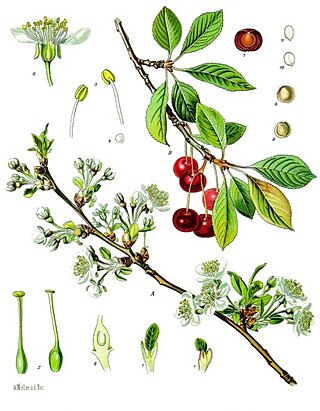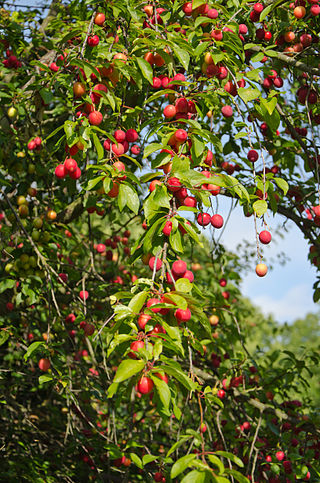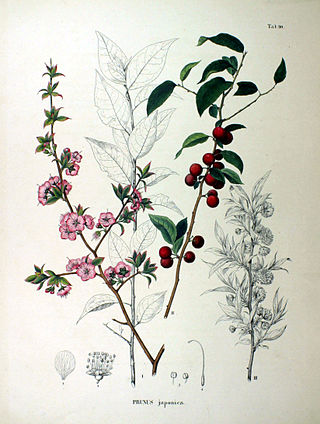
A cherry is the fruit of many plants of the genus Prunus, and is a fleshy drupe.

Prunus is a genus of trees and shrubs, which includes the fruits plums, cherries, peaches, nectarines, apricots, and almonds.

Prunus cerasus is a species of Prunus in the subgenus Cerasus (cherries), native to much of Europe, North Africa and West Asia. It is closely related to the sweet cherry, but has a fruit that is more acidic. Its sour pulp is edible.

Prunus cerasifera is a species of plum known by the common names cherry plum and myrobalan plum. It is native to Southeast Europe and Western Asia, and is naturalised in the British Isles and scattered locations in North America. Also naturalized in parts of SE Australia where it is considered to be a mildly invasive weed of bushland near urban centers.

Prunus japonica, also called Japanese bush cherry, Oriental bush cherry, or Korean bush cherry is a shrub species in the genus Prunus that is widely cultivated for ornamental use. Its native range extends from Central China through to the Korean peninsula.

Prunus serotina, commonly called black cherry, wild black cherry, rum cherry, or mountain black cherry, is a deciduous tree or shrub of the genus Prunus. Despite being called black cherry, it is not very closely related to the commonly cultivated cherries such as sweet cherry, sour cherry and Japanese flowering cherries which belong to Prunus subg. Cerasus. Instead, P. serotina belongs to Prunus subg. Padus, a subgenus also including Eurasian bird cherry and chokecherry. The species is widespread and common in North America and South America.
Dwarf cherry as a name has been used for at least three species of small cherry trees:

Prunus pumila, commonly called sand cherry, is a North American species of cherry in the rose family. It is widespread in eastern and central Canada from New Brunswick west to Saskatchewan and the northern United States from Maine to Montana, south as far as Colorado, Kansas, Indiana, and Virginia, with a few isolated populations in Tennessee and Utah. It grows in sandy locations such as shorelines and dunes.

Prunus tomentosa is a species of Prunus native to northern and western China, Korea, Mongolia, and possibly northern India. Common names for Prunus tomentosa include Nanjing cherry, Korean cherry, Manchu cherry, downy cherry, Shanghai cherry, Ando cherry, mountain cherry, Chinese bush cherry, and Chinese dwarf cherry.

Prunus avium, commonly called wild cherry, sweet cherry, gean, or bird cherry is a species of cherry, a flowering plant in the rose family, Rosaceae. It is native to Europe, Anatolia, Maghreb, and Western Asia, from the British Isles south to Morocco and Tunisia, north to the Trondheimsfjord region in Norway and east to the Caucasus and northern Iran, with a small isolated population in the western Himalaya. The species is widely cultivated in other regions and has become naturalized in North America and Australia.
P. fruticosa may refer to:

Prunus nipponica, also called Japanese alpine cherry, is a shrub which originates from the islands of Hokkaido and Honshu, Japan. It grows to a height of about 5 meters (16 ft) and can grow in sandy, loamy, and clay soils.

Prunus pseudocerasus or Prunus pseudo-cerasus, the Chinese sour cherry or just Chinese cherry, is a species of cherry native to China and is used worldwide as an ornamental for its early spring cherry blossoms. The fruits of some cultivars are edible.

Prunus × cistena, the purple leaf sand cherry or dwarf red-leaf plum, is a hybrid species of Prunus, the result of a cross between Prunus cerasifera and Prunus pumila. A deciduous leggy bush or shrubby tree, it typically reaches a height of 1.5–2.5 meters and has a useful life of 10–20 years. The fruits are edible, if strong-tasting. Some people make jams or preserves from them. It is not advisable to eat the pits.

Prunus canescens, the gray-leaf cherry, is a species of cherry native to China, found in Hubei and Sichuan provinces. A shrubby tree, it grows to about 3 m. It is a parent of a number of hybrid rootstocks for sweet cherries, and occasionally grown as an ornamental for its attractive shiny brown bark.

Prunus tianshanica, the Tianshan cherry, is a species of cherry native to the Tianshan Mountains of Central Asia, preferring to grow at 800-1000 m.

Prunus subg. Cerasus is a subgenus of Prunus. Species of the subgenus have a single winter bud per axil. The flowers are usually in small corymbs or umbels of several together, but some species have short racemes. The fruit is a drupe and has no obvious groove along the side. The subgenus is native to the temperate regions of the Northern Hemisphere, with two species in North America, four in Europe, two in North Africa, and the remainder in Asia.

Prunus × eminens or Prunus eminens is a species of small cherry tree native to central Europe. It is a naturally occurring hybrid of sour cherry, Prunus cerasus, and dwarf cherry, Prunus fruticosa, occasionally found where their ranges overlap. Like its parents, it is a tetraploid with 32 chromosomes. It is forming a hybrid swarm with, and threatening to extirpate, P. fruticosa in much of its western range through genetic pollution.
Prunus × mohacsyana is a hybrid species of cherry. It is a naturally occurring offspring of dwarf cherry, Prunus fruticosa, and introduced sweet cherry, Prunus avium, found where their ranges overlap in Central Europe. Since the hybrids are triploid, they are probably sterile. It was first formally described in 1944 by Zoltán Kárpáti.

Prunus sect. Microcerasus is a section of Prunus. It used to be included in Prunus subg. Cerasus, but phylogenetic research indicates it belongs to Prunus subg. Prunus. It differs from Prunus subg. Cerasus by having three winter buds per axil.


















